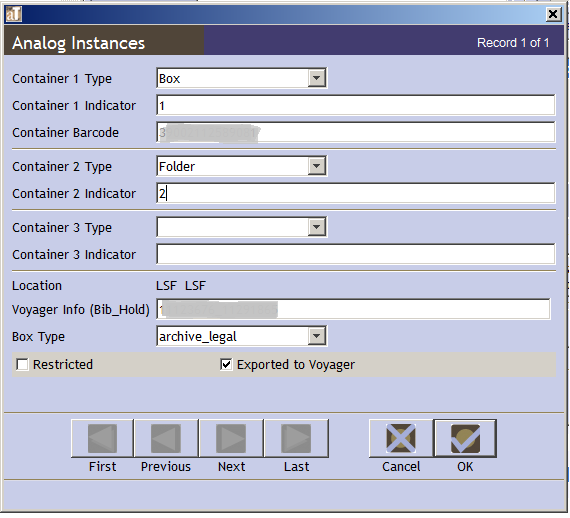It’s no surprise to anyone who has been reading this blog that I am a firm believer in building a processing program that relies heavily on minimal processing techniques, including developing a program that applies different levels of processing to collections, or parts of collections. Describing our collections is one of the most important things that we as archivists do, and also one of the most time-consuming and expensive. We want to make sure that our time and intellectual capital is being well spent, and I firmly believe that the thoughtful, intentional application of processing levels is a really important way to ensure that. This leads to more accessible collections, encourages collection-level thinking and analysis, and opens up archivists’ time to work on big, strategic projects.
Standards like DACS encourage this kind of collection-level thinking and support different levels of arrangement and description, but there’s not a lot of advice out there about how and when to apply each of these levels (though the University of California’s Efficient Processing Guidelines, as always, does a great job of this). How do we decide if a collection is a good candidate to describe at the collection level versus the file level? And what principles guide these decisions? Here I’ll give you some thoughts into the principles I’ve used to build a levels-based processing program, and then some criteria I use when making decisions about an individual collection.
Thinking Programatically
Put Your Thinking Cap On:
Start by analyzing the records (their content and context) at a high level. What does the collection as a whole tell us? What are the major pieces of the collection and how do they relate to each other? Why does that matter? How can be best expose all of this to researchers? I’m not gonna lie- this is hard. This is way harder than making a container list. However, it brings a lot more value to the table. Archivists are trained to understand the ways that records are created; and to assess their potential value as evidence, information, and/or as symbols. Often by doing this higher level intellectual work at the outset we can create very robust and meaningful description that exposes how the parts of the whole of the collection come together and how they function without doing a significant amount of work in the collection.
Define Terms and Build Consensus:
Be clear about what you mean by a level of processing. It is critical that all stakeholders—archivists, curators, research services staff, donors—are all on the same page about what it means for a collection to be arranged and described at a certain level. This means defining and documenting these terms and circulating them widely throughout the organization. It also means being clear about amount of both time and money required to arrange and describe collections to different levels.
It’s also very important to involve institutional stakeholders in your decision making process. Assessing stakeholder needs and managing expectations from the outset helps to ensure that processing projects go smoothly and end with happy stakeholders. In my institution this generally means that the archivists work with with curators to make sure that we understand the value and needs of the collection, that they understand what I mean by a certain level of description, and that I can clearly communicate how more detailed processing of one collection impacts the time and resources available to address other projects that individual has a stake in.
Always Look For the Golden Minimum:
I always approach assigning processing levels by determining what the goals for a collection are (determined in conjunction with stakeholders!) are and what path provides the lowest set of barriers to getting there. Greene and Meissner call this sweet spot where you meet your stated needs with the lowest investment of time and resources the golden minimum and this should be the goal of all processing projects.
Processing is Iterative:
This is huge for me. I go back and tweak description ALL THE TIME. Sometimes I’ve straight up misjudged what amount of description was necessary to facilitate discovery, sometimes research interests and needs change and the old levels of arrangement or description didn’t cut it anymore. Your needs change and evolve, the researchers needs change and evolve over time, the institutional context changes, sometimes you realize that something, for whatever reason just isn’t working. You always have the option to go back into a collection and do more. You never, however, have the ability to recapture the time that you spent on a collection up front, so be thoughtful about how you apply that time to best meet the needs of the institution, the researchers, you and your colleagues, and the collection itself.
Arrangement and Description are Not the Same Thing:
And don’t need to happen at the same level nor happen at the same level across all parts of a collection. A collection can be arranged at the series level and described at the file level. Or completely unarranged but described at the series level. By breaking apart these two aspects of processing we have more flexibility in how we approach and make available collections, and we can be more efficient and effective in managing each individual collection and serving our users.
Discovery and Access are Key:
At the end of the day, the main things to keep in mind when determining the most appropriate processing level are discovery and access. The main goal of any processing project is to give users enough information in our description to both identify the material they are most interested in, and to be able to put their hands on it. How much description is necessary to find relevant material in a collection? What do you need to know to successfully retrieve that relevant box?
Making Decisions at the Collection Level
Now that we know why we’re doing this, and what principles are guiding the application of processing levels, here are some criteria that I use to determine what the most appropriate levels of arrangement and description for a collection are:
- Research Value and Use: If a collection has a high research value and you anticipate heavy and sustained use, it may well be worthwhile to invest additional time and resources into it in at the outset. This is especially true if the collection is not well ordered or is difficult to access.
- Institutional Priorities: While I tend to default towards more minimal processing most of the time, there are plenty of internal factors that may encourage me to apply more detailed levels of processing. A flagship collection in an area where we are trying to build collections, if material from a collection is going to be featured in an exhibition, how much staff time needs to be devoted to other projects, how administrators allocate resources—all of these may affect processing decisions.
- Restrictions: If a collection has significant access or use restrictions, or if there is a high likelihood that there are materials in the collection that would fall under legal protections such as FERPA or HIPAA (especially if these items are scattered throughout the collection) you will need to arrange the collection at a more granular level to ensure that you are doing your due diligence to meet your legal obligations.
- Material Type and Original (Dis)Order: The nature of a collection and the state in which a repository receives it will also, to some extent, determine the amount of archival intervention that it needs to be usable. If a collection arrives foldered, but entirely without a discernable order, it may require at least a series level sorting to enable a researcher to navigate the collection and locate material of interest. This also means that a collection that arrives unfoldered or without any organization will require more granular processing in order to be able to provide meaningful access. If the material is pretty uniform a collection level description will probably suffice. In general, the greater the diversity of the collection the more description is required to render the collection intelligible.
- Size: I try not to make too many blanket decisions based solely on the size of a collection, but it can be a factor in determining processing levels. A collection that is only one box will not need a tremendous amount of description beyond the collection level because a researcher will only need to request one box to see the entirety of material available—tons of additional description is not going to aid in locating material. Conversely, a collection where one series spans hundreds of boxes will need additional file level description so that a user can isolate and access the part of that series that he or she needs.
These are some of the things that I take into consideration in my role as a manager at an academic special collection library. Other types of repositories and institutional contexts may well have other needs and different criteria. Feel free to add or expand in the comments!


